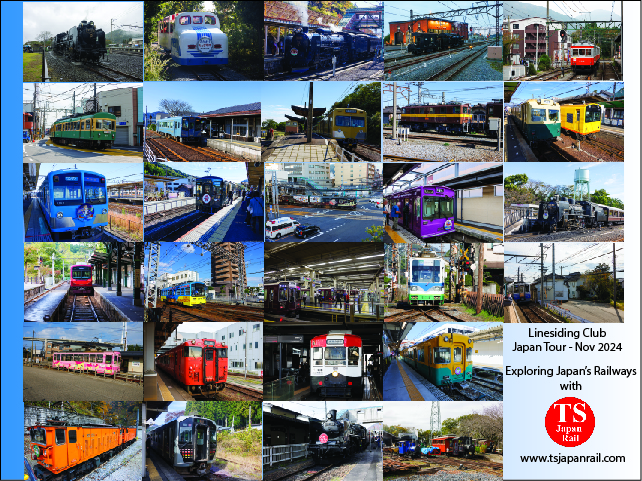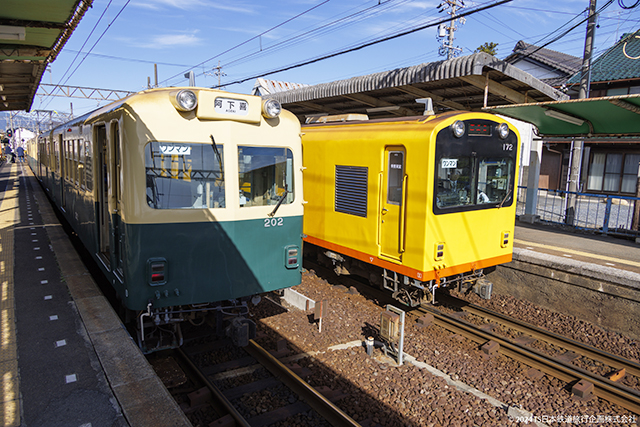Welcome
Welcome to the November 2024 TS Japan Rail Japan Rail Enthusiasts updates and news.
In November after weeks of planning we had a successful group rail tour that took in many different aspects of railways. Please read more about this below.
TS Japan is uniquely positioned to help both individual rail enthusiasts as well as groups visit the many different aspects of Japan Railways. You probably know about the shinkansen, but there is actually a lot more, both modern, not so modern and old, which we know that many rail enthusiasts will find fascinating. Being the Local Experts is where we had value. We also like sharing our passion for Japanese Railways with others!
We are here ready to help you. For groups we work with a local travel agent to get everything into a package, thus making it easier for overseas tour organisers.
See our main site for more information on how we can help you Explore Japan’s Railways
Linesiding Club Japan Tour


Weeks of planning finally came to fruition when 16 members, including the organiser, came together from the UK, Denmark, Austria and Australia in Tokyo at the beginning of November for their Japan Tour.
This was a tour that would take in:
- 4 Steam Locomotive (SL) hauled trains
- 6 tram systems
- 2 Railway Parks
- Lines operated by 32 different railway companies
- Kyoto Railway Museum
- travel on 762mm (2’6″), 1067mm (3’6″), and 1,435mm (4’8 1/2″) gauge (conventional & regular) railways
- many rural as well as urban routes
- Lots of Japanese scenery
The playbook for this 17 day tour was 93 pages long (with some additional pages as we added options).
On many of the lines that we travelled on locals and railway staff were surprised to see so many overseas railway enthusiasts travelling on their trains!
Although tour participants did get a chance to travel on the shinkansen and several Limited Express trains, most travel was by local or ordinary rapid trains, allowing participants to enjoy some of the wonderful Japan scenery.



We are very grateful to have been able to work with the Linesiding Club on this tour, helping them plan and organise what was a very full but interesting itinerary.
We were also happy to get so much positive feedback from participants!
This tour was so successful that the club has already started planning their Japan 2 tour with TS Japan Rail.
Planning to visit Japan in 2025 – Download our 2025 Japan Calendar
If you are planning to visit Japan in 2025 you may find our Japan calendar useful. We have highlighted all the holidays and busy travel times.
You can download the TS Japan Rail 2025 Japan Calendar from our main site TS Japan Rail 2025 Calendar and for more information on the “big holidays” and how they effect rail travel see our main site post Planning a trip to Japan in 2025?
2024 End of Year / 2025 New Year Holiday
One of the big holidays in Japan is the End of Year / New Year holiday (Christmas is not a holiday), when although many extra trains are laid on for most inter city routes, trains will nevertheless be very crowded / fully booked from the 28th December thru to to the 5th January. Please be aware that some trains that may normally have unreserved cars will be all reserved cars during this period (particularlyTokaido, Sanyo and Kyushu shinkansen Nozomi and Mizuho services.)
On 31st December~1st Japan on a number of lines trains will operate either all night or the last train will be later than normal. On other lines there may be extra early morning trains on the 1st January so that people can get to vantage points to see the first sunrise. (see Big holiday’s in Japan information)
Rail fact: Japan Railway Gauges
80% of Japan’s railways operate on the narrow 1067mm (3’6″) gauge. No one is sure why exactly, with two theories:
- Japan’s mountainous topography which means a lot of curves are necessary (particularly in the early days when tunnelling techniques were less developed).
- Cost – narrow gauge railways are less expensive to build.
The cost aspect is likely to be the more likely. Japan started its railway boom during the Meiji era and the plan was to expand the railway network as quickly as possible. UK was an an early influencer and could have influenced the use of the narrow 1067mm gauge (Welsh mountain narrow gauge railways) and also Norway that has an even more mountainous terrain, but both the UK and Norway standardised on the 1435mm gauge.
Japan’s shinkansen uses standard guage (1435mm) and so do several major non JR railway companies. This includes Kintetsu, the largest (by route km) non JR railway in Japan, and the major Keisei and Keikyu Railways. The two earliest subway lines in Tokyo (Ginza and Marunouchi Lines) and the TOEI operated Asakusa Line are also 1435mm).


1372mm and 762mm gauge lines can also be found in Japan. Major Tokyo railway company Keio uses 1372mm on most of its lines. There are three 762mm lines operating in Japan, two are regular lines, both in Mie Prefecture (see Railways in Mie Prefecture article). The third is the industrial / tourist Kurobe Gorge Railway.
The predominance of the 1067mm gauge explains why Japan’s railways are relatively slow compared with other countries (although slowness is often made up by frequency and reliability); and it is noticeable when you travel on Kintetsu, Keisei & Keikyu trains they are much faster (there are places where you can see these services speed past JR services).












